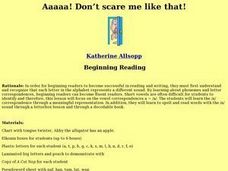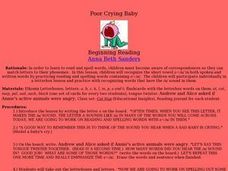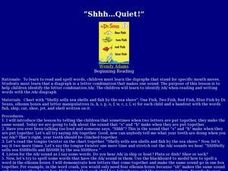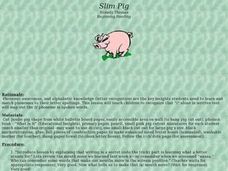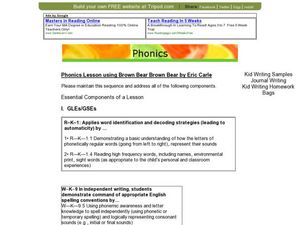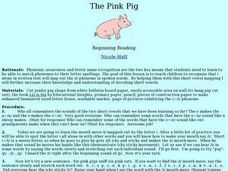Curated OER
Pronunciation of Intonation Patterns
Students in ESOL classes practice communication skills using voice intonation patterns. Using various patterns, they practice sentences with rising and falling intonations. With partners, students read passages orally with emphasis...
Curated OER
Aaaa! Don't Scare Me Like That!
Students practice saying each letter of the alphabet to determine the different sounds from each letter. As a class, they are given a tongue twister to practice making the "a" sound and spelling the words. To end the lesson, they...
Curated OER
Vowels, Reading Fluency
Third graders practice identifying words with the short o vowel sound. They use the strategy will reading a page from The Hare and the Tortoise. They read the passage while focusing on increasing their reading fluency and practice...
Curated OER
Class Alphabet Book
Young scholars are introduced to the Kid Pix software program and its templates. With a partner, they use the internet find a picture that starts with each letter of the alphabet. They practice saying and reading the words to their...
Curated OER
Bob and the Frogs Hop on Logs
Students complete a variety of activities as they explore/review the letter 'o' as it makes the /o/ sound. They recite tongue twisters and practice writing words with the /o/ sound. They read a story and choose /o/ words from the story...
Curated OER
Cat Nap
Students identify and interpret the concept of the vowel /a/ and recognize it in words and illustrations. They also practice writing both upper and lower case A on writing paper. Finally, students name pictures and circle the pictures...
Curated OER
Short Vowels With Clifford
Phonetic masters identify and recognize short vowel sounds by reading and listening to a story that highlights select words. They use picture clues to aid comprehension and construct a story by actively choosing and identifying...
Curated OER
Casper the Cat
Students examine the letter 'a'. Through instruction and modeling and a variety of practice activities, they explore the sound the letter makes and how the letter is written. They recite tongue twisters, read stories and use letterboxes...
Curated OER
Uhh I don't know!
Learners engage in an emergent literacy lesson in order to work on the skill of phonem ic awareness. The use of flashcards is essential for the instruction of the lesson. Students match the card with its beginning phoneme.
Curated OER
Poor Crying Baby
Students examine the letter 'a'. Through instruction and modeling and a variety of practice activities, they explore the sound the letter makes and how the letter is written. They recite tongue twisters and read stories and pick out...
Curated OER
Shhh! Quiet!
Students become aware that when certain letters are put together in a word they are said with a single mouth move. Through modeling and a variety of guided practice activities they explore the /sh/ phoneme. They read and identify 'sh'...
Curated OER
See It, Say It, Move It, Do It!
Learn two new letters a week with this activity! After learning the two target letters, the class will make an alphabet video "performing" each letter. The letter's name, sound, and a motion associated with it will be included in the...
Read Write Think
Poetry Portfolios: Using Poetry to Teach Reading
Over the course of five periods, scholars create a poetry portfolio. They begin with a reading of the poem, Firefly. With a focus on vocabulary, learners reread the poem then look for sight words and other skills.
Curated OER
Slim Pig
Beginning readers study the short /i/ sound. First they determine how the mouth moves when they say the target words in a tongue twister. They complete letterbox activities by making words with the short /i/ before reading What Is It and...
Curated OER
Brown Bear Phonics
Students listen to Brown Bear, Brown Bear and imitate the style of Eric Carle in writing a sentence. In this writing lesson, students use the beginning and ending sounds of words to write an Eric Carle type sentence. ...
Curated OER
"Tongue Tangle"
First graders engage in a study of phonics that focuses on the beginning sounds with an emphasis upon varying types of genres that includes songs, speech, and poetry. They recognize the beginning sounds of words and make physical...
Curated OER
Making Words - With A Twist
Students take a scrambled word and try to make other words using all of the letters. They form words out of playdough as well.
Curated OER
A Seed for All Needs
Students identify uses for plants. For this agricultural lesson, students read the book Spring Gardening and distinguish between food plants and flowers. Students plant flower in cups as a follow-up activity.
Curated OER
Fun On The Farm
Young scholars experiment with a variety of resources to study about sounds and their sources (weather, animal, and transportation). They compare size, structure, and basic needs of living things. Each student studies about farm animals,...
Curated OER
Build a Word
Students explore new words through letters or letter groups. In this activity about words, students use index cards to build new words. Each index card contains one letter or letter group. Students utilize different strategies like...
Curated OER
MMMM MMMM Yummy Cake
Students identify the letter "m" and its sound in this activity. They identify foods that contain the /m/ sound by making a "m" sound. They then listen to the story Stand Tall Molly Lou Melon and identify the /m/ words in the story.
Curated OER
The Pink Pig
Students identify the short /i/ sound in spoken words and the letter symbol in this lesson plan. They say a tongue twister emphasizing words with the short /i/ sound. They then read the story "Liz is Six" and identify the words with...
Curated OER
"Aaaaaa!!!!" Please Don't Cry Baby!
Learners complete a variety of activities as they examine the letter 'a' as it makes the short /a/ sound. Through instruction and modeling, they explore the sound the letter makes and how the letter is written. They recite tongue...
Curated OER
Science: Why Animals Hibernate
Second graders investigate the reasons animals hibernate. They measure their own heart rates and compare them to those of a hibernating bear. In their journals, 2nd graders record facts about and characteristics of hibernation and...



